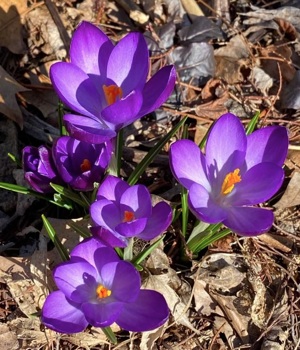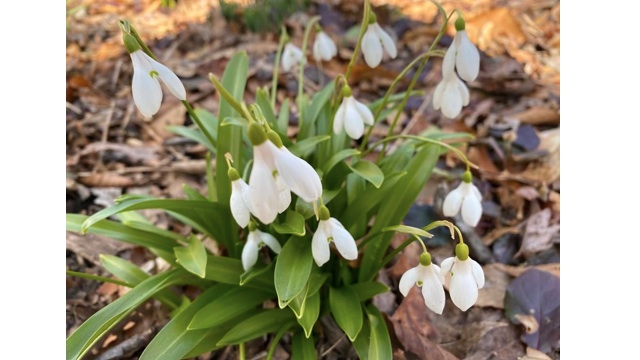Spring, with its promises of warmth and rebirth, can’t come too quickly. When hydrangeas bud and daffodils bloom, hope flowers as well. Now, more than ever, we need our gardens. For advice on how to tend them, we turned to LongHouse Reserve’s Holger Winenga, the third generation German horticulturist who has been guiding Hamptons estates for 25 years, first as the owner of the Garden Treasure Nursery, a place for unusual as well as popular perennials, and today, after a 15 year association with LongHouse’ Jack Lenor Larson, as their head horticulturist.
LongHouse — where living art landscapes frame sculptures by Buckminster Fuller, Yoko Ono, Willem de Kooning and more — is often considered a Hamptons secret garden. During this lockdown, it’s the private paradise of Winenga, his social distancing staff of five, and owner/founder Larson.
Holger took a break from overseeing LongHouse’s magical 16 acres to answer some of our questions, including, on the minds of many: growing our own vegetables.
 |
|
Crocuses. (Photo Courtesy of LongHouse Reserve) |
First, start weeding. “Get rid of them before they go to seed and become a real nuisance,” Winenga told us. “Then mulch the ground. That keeps them from coming back, and moisture in the soil.” LongHouse, which has an educational component, also promotes sustainable, perennial ground covers, to resolve the issue. Holger likes hardy geraniums, European ginger and epimediums.
It’s also time to deadhead your roses and hydrangeas. Remove the stalks that died over the winter, i.e. the ones with no growth.
Keep tick borne diseases at bay by attacking them now when they are in the early nymphal stage. Winenga recommends using an organic cedar oil spray on grounds once or twice a month, depending on deer exposure.
Fertilize your plants sparingly and organically. Older plants, without issues, don’t need to be fertilized every year. Composting is best. Too much store bought fertilizer is bad for the groundwater and, in some plants, can attract mealybugs and other insects.
Shopping for new plants and annuals will be a little different this year. For example, Fowler’s takes orders by phone and delivers to your car. Marders’ interior store doors are also closed, but they have a pick up business and require masks and social distancing on their grounds. Eastlands Nursery & Farms has seven outdoor acres, making safe practices easy to follow.
What to buy? Winenga is the perennial expert in more ways than one. “Perennials don’t bloom all summer,” he said. “But, if you choose the right combination, you will always have something interesting.” LongHouse prides itself on keeping its gardens blooming through the whole season, with witch hazels, hellebores and snowdrops blooming in the winter. “Start with bulbs. Daffodils are beautiful right now,” Winenga suggests. “Some early perennials are nepeta, baptisia.” For shadier spots, he suggests palmenaria, forget me nots, epimediums, hardy geraniums, Japanese anemones, cimicisugas and aconitums.
And those vegetable gardens that everyone seems to want? “Arugula, mesclun, spinach, kale, carrots and radishes can start as early as March,” Winenga told us. “You can start seedlings for cucumbers, tomatoes and squashes in window pots now and plant them outside around Memorial Day. Instead of flowers, try growing vegetables in pots on the patio. Parsley, rosemary, and chives, can be taken in after the season to use year round. Fill 21-30 inch clay pots with local heirloom cherry and cutting tomatoes in the center, and surround them with lettuce.” Don’t grow your Israeli salad ingredients together: cucumbers and tomatoes don’t do well in the same pot.
 |
|
Galanthus woronowii. (Photo Courtesy of LongHouse Reserve) |
It’s doubtful your efforts will make you self sufficient. “You probably need 1/2 acre per person to live on your garden,” Holger said. “Growing food is about growing peace of mind. It’s a therapeutic way to supplement your fresh produce, a great learning activity for kids and a way to reduce grocery trips.”
Here are examples of Winenga’s recommendations, in flowering sequence, for a perennial garden:
Early Dwarf daffodils
Camassia
Nepeta faassenii
Calamintha
Baptisia in many new varieties
Coreopsis verticillata
Salvia nemorosa in varieties and colors
Stachys densiflora ‘Humelo’
Echinacea
Hemerocallis
Lythrum
Monarda
Heliopsis
Helenium
Helianthus
Thalictrum
Eupatorium
Fall Asters
Hardy Chrysanthamum
Winenga also recommends these ground coverings
Asarum europaeum
Epimedium perralderianum
Geranium macrorhizzum (all varieties)
Gallium odoratum
Geranium x cantabrigense ‘Biokovo’ or ‘Karmina’
Omphalodes verna
Pulmonarias
Symphytum grandiflorum
Vinca minor
Waldsteinia ternata
For more information: www.longhouse.org.












